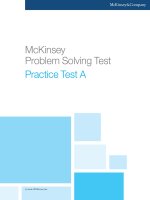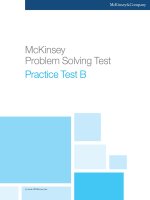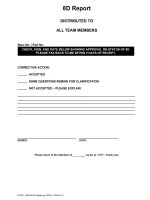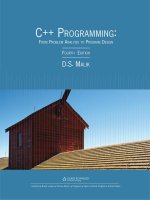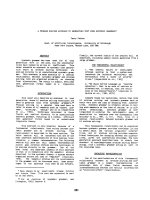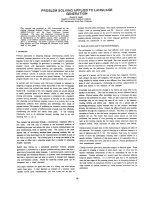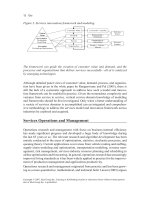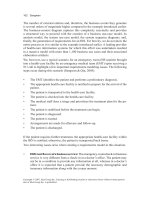Autonomy oriented computing from problem solving to complex systems modeling
Bạn đang xem bản rút gọn của tài liệu. Xem và tải ngay bản đầy đủ của tài liệu tại đây (6.93 MB, 249 trang )
Autonomy Oriented
Computing
From Problem Solving to
Complex Systems Modeling
MULTIAGENT SYSTEMS,
ARTIFICIAL SOCIETIES, AND
SIMULATED ORGANIZATIONS
International Book Series
Series Editor: Gerhard Weiss, Technische Universität München
Editorial Board:
Kathleen M. Carley, Carnegie Mellon University, PA, USA
Yves Demazeau,CNRS Laboratoire LEIBNIZ, France
Ed Durfee, University of Michigan, USA
Les Gasser, University of Illinois at Urbana-Champaign, IL, USA
Nigel Gilbert, University of Surrey, United Kingdom
Michael Huhns, University of South Carolina, SC, USA
Nick Jennings, University of Southampton, UK
Victor Lesser, University of Massachusetts, MA, USA
Katia Sycara, Carnegie Mellon University, PA, USA
Michael Wooldridge, University of Liverpool, United Kingdom
Books in the Series:
CONFLICTING AGENTS: Conflict Management in Multi-Agent Systems, edited by
Catherine Tessier, Laurent Chaudron and Heinz-Jürgen Müller, ISBN: 0-7923-7210-7
SOCIAL ORDER IN MULTIAGENT SYSTEMS, edited by Rosaria Conte and Chrysanthos
Dellarocas, ISBN: 0-7923-7450-9
SOCIALLY INTELLIGENT AGENTS: Creating Relationships with Computers and
Robots, edited by Kerstin Dautenhahn, Alan H. Bond, Lola Cañamero and Bruce Edmonds,
ISBN: 1-4020-7057-8
CONCEPTUAL MODELLING OF MULTI-AGENT SYSTEMS:
Engineering Environment, by Norbert Glaser, ISBN: 1-4020-7061-6
The
CoMoMAS
GAME THEORY AND DECISION THEORY IN AGENT-BASED SYSTEMS, edited by
Simon Parsons, Piotr Gmytrasiewicz, Michael Wooldridge, ISBN: 1-4020-7115-9
REPUTATION IN ARTIFICIAL SOCIETIES: Social Beliefs for Social Order, by Rosaria
Conte, Mario Paolucci, ISBN: 1-4020-7186-8
AGENT AUTONOMY, edited by Henry Hexmoor, Cristiano Castelfranchi, Rino Falcone,
ISBN: 1-4020-7402-6
AGENT SUPPORTED COOPERATIVE WORK, edited by Yiming Ye, Elizabeth
Churchill, ISBN: 1-4020-7404-2
DISTRIBUTED SENSOR NETWORKS, edited by Victor Lesser, Charles L. Ortiz, Jr.,
Milind Tambe, ISBN: 1-4020-7499-9
AN APPLICATION SCIENCE FOR MULTI-AGENT SYSTEMS, edited by Thomas A.
Wagner, ISBN: 1-4020-7867-6
METHODOLOGIES AND SOFTWARE ENGINEERING FOR AGENT SYSTEMS: The
Agent-Oriented Software Engineering Handbook, edited by Federico Bergenti, Marie-Pierre
Gleizes, Franco Zambonelli
Autonomy Oriented
Computing
From Problem Solving to
Complex Systems Modeling
Jiming Liu
Xiaolong Jin
Kwok Ching Tsui
Hong Kong Baptist University
KLUWER ACADEMIC PUBLISHERS
NEW YORK, BOSTON, DORDRECHT, LONDON, MOSCOW
eBook ISBN:
Print ISBN:
1-4020-8122-7
1-4020-8121-9
©2005 Springer Science + Business Media, Inc.
Print ©2005 Kluwer Academic Publishers
Boston
All rights reserved
No part of this eBook may be reproduced or transmitted in any form or by any means, electronic,
mechanical, recording, or otherwise, without written consent from the Publisher
Created in the United States of America
Visit Springer's eBookstore at:
and the Springer Global Website Online at:
To my parents, my wife, Meilee,
and my two daughters, Isabella and Bernice,
who have given me life, love,
inspiration, and purpose.
Jiming Liu
To my wife, Zhen, and my parents,
for their continuous support and endless love.
Xiaolong Jin
To May and Abigail,
the source of unceasing love,
and God the Creator.
Kwok Ching Tsui
This page intentionally left blank
Contents
List of Figures
List of Tables
List of Algorithms
Preface
Acknowledgments
Part I
xv
xix
xxi
xxiii
xxxi
FUNDAMENTALS
1. From Autonomy to AOC
1.1 Introduction
1.1.1 Complex Multi-Entity Systems
1.1.2 Complex Systems Modeling
1.2 Basic Concepts and Taxonomies
1.2.1 Types of Behavior
1.2.2 Autonomy Defined
3
3
3
4
1.3 General AOC Approaches
1.4 AOC as a New Computing Paradigm
1.4.1 Basic Building Blocks
1.4.2 Computational Methodologies
1.5 Related Areas
1.6 Summary
Exercises
5
5
6
7
8
9
10
11
12
14
2. AOC at a Glance
2.1 Introduction
2.2 Autonomy Oriented Problem Solving
15
15
15
viii
AUTONOMY ORIENTED COMPUTING
2.2.1 Autonomy Oriented Modeling
2.2.2 N-Queen Problem
2.3 Autonomy Oriented Search
2.3.1 Autonomy Oriented Modeling
2.3.2 Image Segmentation Problem
2.3.3 An Illustrative Example
2.3.4 Computational Steps
2.4 Autonomy Oriented Learning
2.4.1 World Modeling
2.4.2 Self-Organization
2.4.3 Adaptation
2.5 Summary
Exercises
15
16
17
17
17
19
19
21
21
22
24
25
26
3. Design and Engineering Issues
3.1 Introduction
3.2 Functional Modules in an Autonomous Entity
3.3 Major Phases in Developing AOC Systems
3.4 Engineering Issues
3.5 Features and Characteristics of AOC Systems
3.6 Performance Considerations
3.7 Simulation Environments
3.8 Summary
Exercises
27
27
27
29
31
33
34
36
36
38
4. A Formal Framework of AOC
4.1 Introduction
4.2 Elements of an AOC System
4.2.1 Environment
4.2.2 Autonomous Entities
4.2.3 System Objective Function
4.3 Interactions in an AOC System
4.3.1 Interactions between Entities and their
Environment
4.3.2 Interactions among Entities
4.4 Remarks on Homogeneity, Heterogeneity, and
Hierarchy of Entities
4.5 Self-Organization in AOC
39
39
39
40
40
44
44
44
45
48
48
Contents
4.6
ix
4.5.1 What is Self-Organization?
4.5.2 How Does an AOC System Self-Organize?
Summary
Exercises
48
49
52
54
Part II AOC IN DEPTH
5. AOC in Constraint Satisfaction
57
5.2
Background
5.2.1 Conventional Methods
5.2.2 Self-Organization Based Methods
5.2.3 ERE vs. other Methods
57
58
60
62
62
64
65
5.3
ERE Model
5.3.1 General Ideas
5.3.2 Environment
5.3.3 ERE Entities
5.3.4 System Schedule
5.3.5 Computational Cost
5.3.5.1 Space Complexity
5.3.5.2 Time Complexity
66
68
70
72
75
76
76
78
5.4
An Illustrative Example
79
81
81
82
83
84
5.1 Introduction
5.1.1 e-Learning
5.1.2 Objectives
5.5 Experimentation
5.5.1 N-Queen Problems
5.5.2 Benchmark SAT Problems
5.5.2.1 Fair Measurement
5.5.2.2 Performance Evaluation
5.6
Discussions
5.6.1 Necessity of the Better-Move Behavior
5.6.2 Probability Setting
5.6.3 Variable Grouping
5.6.4 Characteristics of ERE
5.6.5 Comparisons with Existing Methods
5.6.5.1 Comparison with Min-Conflicts
Heuristics
86
86
87
87
88
88
88
AUTONOMY ORIENTED COMPUTING
x
Comparison with Distributed
Constraint Satisfaction
5.6.5.3 Remarks on Partial Constraint
Satisfaction
5.6.5.4 Remarks on Entity Information and
Communication for Conflict-Check
5.6.5.5 Remarks on Sequential Implementation
Entity Network for Complexity Analysis
5.7.1 Different Representations
5.7.1.1 Clause Based Representation
5.7.1.2 Variable Based Representation
5.7.2 Discussions on Complexity
5.7.2.1 Complexities under Different
Representations
5.7.2.2 Balanced Complexities in Intra- and
Inter-Entity Computations
5.7.2.3 A Guiding Principle
Summary
5.8.1 Remarks on ERE
5.8.2 Remarks on AOC by Fabrication
Exercises
5.6.5.2
5.7
5.8
6. AOC in Complex Systems Modeling
6.1 Introduction
6.1.1 Regularity Characterization
6.1.2 Objectives
6.2 Background
6.2.1 Web Mining for Pattern Oriented Adaptation
6.2.1.1 Web Data Mining
6.2.1.2 User Behavior Studies
6.2.1.3 Adaptation
6.2.2 Web Mining for Model Based Explanation
6.2.2.1 Web Regularities
6.2.2.2 Regularity Characterization
6.3 Autonomy Oriented Regularity Characterization
6.3.1 Artificial Web Space
6.3.1.1 Web Space and Content Vector
Representations
6.3.1.2 Modeling Content Distributions
6.3.1.3 Constructing an Artificial Web
90
91
92
92
93
94
94
97
99
99
99
100
100
100
101
104
105
105
106
106
107
107
108
108
108
109
109
110
110
111
111
112
113
Contents
6.3.1.4 Remarks on the Artificial Web Server
6.3.1.5 Dynamically Generated Web Pages
6.3.2 Foraging Entities
6.3.2.1 Interest Profiles
6.3.2.2 Modeling Interest Distributions
6.3.2.3 Motivational Support Aggregation
6.3.3 Foraging in Artificial Web Space
6.3.3.1 Navigation Strategies
6.3.3.2 Preference Updating
6.3.3.3 Motivation and Reward Functions
6.3.3.4 Foraging
6.4 Experimentation
6.4.1 Experiments
6.4.2 Validation Using Real-World Web Logs
6.5 Discussions
6.5.1 Foraging Depth
6.5.2 Link Click Frequency
6.5.3 Degree of Coupling
6.5.4 Mixed Entity Population
6.5.5 Satisfaction vs. Unsatisfaction
6.5.6 Other Factors
6.6 Summary
6.6.1 Remarks on Regularity Characterization
6.6.2 Remarks on AOC by Prototyping
Exercises
7. AOC in Optimization
7.1 Introduction
7.1.1 Optimization Tasks
7.1.1.1 Investment Portfolio Optimization
7.1.1.2 Telecommunication Network Design
7.1.2 Objectives
7.2 Background
7.2.1 Common Stochastic Search Algorithms
7.2.1.1 Simulated Annealing
7.2.1.2 Evolutionary Algorithms
7.2.1.3 Adaptive Evolutionary Algorithms
7.2.2 Diffusion in Natural Systems
7.3 EDO Model
xi
114
114
114
115
115
116
117
117
119
119
120
121
121
123
128
129
131
133
141
144
145
145
147
147
150
151
151
151
152
153
153
155
155
155
155
156
156
157
AUTONOMY ORIENTED COMPUTING
xii
Diffusion
Reproduction
7.3.2.1 Reproduction Quota
7.3.2.2 Rejuvenation
7.3.3 Aging
7.3.4 Feedback
7.3.5 Global Information
7.4 Benchmark Optimization Problems
7.5 Performance of EDO
7.5.1 Basic EDO with More Features
7.5.2 Clustering around the Optimal Solution
7.5.3 Summary
7.6 Experimentation
7.6.1 Unimodal Functions
7.6.2 Multimodal Functions
7.7 Discussions
7.7.1 Computational Cost
7.7.1.1 Space Complexity
7.7.1.2 Time Complexity
7.7.2 Feature Comparisons
7.7.2.1 Simulated Annealing
7.7.2.2 Evolutionary Algorithms
7.7.2.3 Particle Swarm Optimization
7.7.2.4 Ant Colony Optimization
7.7.2.5 Cultural Algorithms
7.8 Summary
7.8.1 Remarks on EDO
7.8.2 Remarks on AOC by Self-Discovery
Exercises
7.3.1
7.3.2
8. Challenges and Opportunities
8.1 Lessons Learned
8.2 Theoretical Challenges
8.3 Practical Challenges
8.3.1 Hardware and Software Environments
8.3.2 Update Schedule
8.3.3 Management Services
8.3.4 Visualization
158
160
160
161
161
162
163
164
165
168
168
172
173
173
176
178
178
179
180
180
180
181
183
183
184
185
185
185
187
189
189
192
192
192
193
193
193
Contents
8.4
xiii
Summary
Exercises
194
195
References
197
Index
213
This page intentionally left blank
List of Figures
2.1
2.2
2.3
3.1
3.2
3.3
4.1
4.2
4.3
5.1
5.2
5.3
5.4
5.5
5.6
5.7
5.8
5.9
5.10
5.11
5.12
5.13
6.1
An illustration of the behavior of autonomous entities.
Segmenting a landscape image.
An illustration of the distance association scheme.
Functional modules in an autonomous entity.
Major phases in developing an AOC system.
Ranking AOC approaches according to their
engineering requirements.
Interactions between two entities.
Direct interactions between an entity and its two neighbors.
The process of self-organization in an AOC system.
An e-learning application.
A solution to a 4-queen problem.
An illustration of the entity model in Example 5.3.
An illustration of the entity model in Example 5.4.
An illustration of the ERE method in Example 5.3.
An illustration of the ERE method in Example 5.4.
Entity movements at different steps.
An illustration of the ERE method in Example 5.5.
The first step in the ERE process.
The second step in the ERE process.
Representing three clauses into an entity network.
Representing a clause into an entity network.
The AOC-by-fabrication approach.
Recurrent entity foraging depth in Experiment 6.1.
18
20
23
28
30
32
46
47
51
60
61
68
69
71
72
76
80
80
80
94
97
102
123
AUTONOMY ORIENTED COMPUTING
xvi
6.2
6.3
6.4
6.5
6.6
6.7
6.8
6.9
6.10
6.11
6.12
6.13
6.14
6.15
6.16
6.17
6.18
6.19
6.20
6.21
6.22
6.23
6.24
6.25
6.26
6.27
6.28
6.29
6.30
Link-click-frequency with recurrent entities in Experiment 6.1. 124
Rational entity foraging depth in Experiment 6.1.
125
Link-click-frequency with rational entities in Experiment 6.1. 126
User surfing steps as observed from the NASA Web log data. 126
Link-click-frequency as observed from the NASA Web
log data.
127
User surfing steps as observed from the GIT-lab Web
log data.
127
Link-click-frequency as observed from the GIT-lab Web
log data.
128
Recurrent entities visiting domains in Experiment 6.1.
129
Rational entities visiting domains in Experiment 6.1.
130
User surfing steps in accessing domains as observed
from the Microsoft Web log data.
130
132
Recurrent entity foraging depth in Experiment 6.2.
Rational entity foraging depth in Experiment 6.2.
133
134
Recurrent entity foraging depth in Experiment 6.3.
Rational entity foraging depth in Experiment 6.3.
135
Link-click-frequency with recurrent entities in Experiment 6.2. 136
Link-click-frequency with rational entities in Experiment 6.2. 136
Link-click-frequency with recurrent entities in Experiment 6.3. 137
Link-click-frequency with rational entities in Experiment 6.3. 137
Link-click-frequency with random entities in Experiment 6.1. 138
Link-click-frequency with random entities in Experiment 6.2. 138
The average number of links in Experiment 6.4.
139
139
Power values in Experiment 6.4.
140
Average foraging steps in Experiment 6.4.
140
Satisfaction rate in Experiment 6.4.
The combined measure of entity foraging depth and
141
satisfaction rate in Experiment 6.4.
Entity foraging depth with a mixed population in
142
Experiment 6.5.
Entity foraging depth in accessing domains with a mixed
143
population in Experiment 6.5.
Link-click-frequency with a mixed population in
143
Experiment 6.5.
145
Recurrent entity foraging depth in Experiment 6.6.
List of Figures
6.31
6.32
6.33
6.34
7.1
7.2
7.3
7.4
7.5
7.6
7.7
7.8
7.9
7.10
7.11
Rational entity foraging depth in Experiment 6.6.
Satisfaction rate in Experiment 6.6.
Average steps in accessing domains in Experiment 6.6.
The AOC-by-prototyping approach.
The best and average values for a solution to unimodal
function
The relative performance advantages of step size adaptation, random-move, and solution rejuvenation strategies.
The two-dimensional unimodal function
The multimodal function
Entity distribution in the search space for two-dimensional
unimodal function
(a)-(f).
Entity distribution in the search space for two-dimensional
unimodal function
(g)-(l).
Entity distribution in the search space for multimodal
function (a)-(f).
Entity distribution in the search space for multimodal
function (g)-(l).
The best function value found by EDO and the number of entities used at each iteration for two unimodal
functions, and
in 5 to 30 dimensions.
The best function value found by EDO and the number
of entities used at each iteration for two multimodal
functions, and
The AOC-by-self-discovery approach.
xvii
146
146
147
148
166
167
169
170
171
172
173
174
175
177
186
This page intentionally left blank
List of Tables
1.1
2.1
5.1
5.2
5.3
5.4
5.5
5.6
5.7
6.1
6.2
6.3
6.4
A comparison of OOP, AOP, and AOC.
Computational steps in autonomy oriented segmentation.
Performance in the first three steps of ERE-based
n-queen problem solving.
Mean-movement(flip)-numbers in benchmark SATs.
The number of satisfied clauses and its ratio to the total
number of clauses in Experiment 5.4.
The number of satisfied clauses and its ratio to the total
number of clauses in Experiment 5.5.
The number of satisfied clauses and its ratio to the total
number of clauses in Experiment 5.6.
Clause-based representation for benchmark SATs:
Uniform-3-SAT and Flat Graph Coloring.
Variable-based representation for benchmark SATs:
Uniform-3-SAT and Flat Graph Coloring.
Parameters in Experiment 6.1.
Parameters in Experiment 6.2.
Parameters in Experiment 6.3.
Parameters in Experiment 6.6.
10
20
82
83
85
85
86
96
98
122
131
132
144
This page intentionally left blank
List of Algorithms
5.1
5.2
5.3
6.1
6.2
7.1
7.2
7.3
7.4
7.5
7.6
7.7
The Davis-Putnam algorithm.
The local search algorithm.
The ERE algorithm.
Constructing artificial Web space.
The foraging algorithm.
The EDO algorithm.
The adaptive simulated annealing (ASA) algorithm.
A typical population-based evolutionary algorithm.
A typical mutation only evolutionary algorithm.
The particle swarm optimization (PSO) algorithm.
The ant colony optimization (ACO) algorithm.
The cultural algorithm.
64
65
77
113
121
158
180
182
182
183
184
184
This page intentionally left blank
Preface:
Towards a New Computing Paradigm
With the advent of computing, we are fast entering a new era of discovery
and opportunity. In business, market researchers will be able to predict the potential market share of a new product on-the-fly by synthesizing news reports,
competitor analysis, and large-scale simulations of consumer behavior. In life
and material sciences, specially engineered amorphous computational particles will be able to perform optimal search, whether they are bio-robot agents
to kill cancer cells inside human bodies or smart paints to spread evenly over
and fill cracks on rugged surfaces. In environmental sciences, surveillance applications will be able to deploy wireless, mobile sensor networks to monitor
wild vegetation and route the tracking measurements of moving objects back
to home stations efficiently and safely. In robotics, teams of rescue or Mars
exploratory robots will be able to coordinate their manipulation tasks in order
to collectively accomplish their missions, while making the best use of their
capabilities and resources.
All the above examples exhibit a common characteristic, that is, the task
of computing is seamlessly carried out in a variety of physical embodiments.
There is no single multi-purpose or dedicated machine that can manage to
accomplish a job of this nature. The key to success in such applications lies
in a large-scale deployment of computational agents capable of autonomously
making their localized decisions and achieving their collective goals.
We are now experiencing a world in which the traditional sense of computers is getting obsolete. It calls for a more powerful, intelligent computing
paradigm for handling large-scale data exploration and information processing. We are in a critical moment to develop such a new computing paradigm in
order to invent new technologies, to operate new business models, to discover
xxiv
AUTONOMY ORIENTED COMPUTING
new scientific laws, and even to better understand the universe in which we
live.
In human civilizations, science and technology develop as a result of our
curiosity to uncover such fundamental puzzles as who we are, how the universe evolves, and how nature works, multiplied by our desires to tackle such
practical issues as how to overcome our limitations, how to make the best use
of our resources, and how to sustain our well-being.
This book is a testimony of how we embrace new scientific and technological development in the world of computing. We specifically examine the
metaphors of autonomy as offered by nature and identify their roles in addressing our practical computing needs. In so doing, we witness the emergence of a
new computing paradigm, called autonomy oriented computing (AOC).
Autonomy Oriented Computing
While existing methods for modeling autonomy are successful to some extent, a generic model or framework for handling problems in complex systems, such as ecological, social, economical, mathematical, physical, and natural systems, effectively is still absent. Autonomy oriented computing (AOC)
unifies the methodologies for effective analysis, modeling, and simulation of
the characteristics of complex systems. In so doing, AOC offers a new computing paradigm that makes use of autonomous entities in solving computational
problems and in modeling complex systems. This new paradigm can be classified and studied according to (1) how much human involvement is necessary
and (2) how sophisticated a model of computational autonomy is, as follows:
AOC-by-fabrication: Earlier examples with this approach are entity-based
image feature extraction, artificial creature animation, and ant colony optimization. Lifelike behavior and emergent intelligence are exhibited in such
systems by means of fabricating and operating autonomous entities.
AOC-by-prototyping: This approach attempts to understand self-organized
complex phenomena by modeling and simulating autonomous entities. Examples include studies on Web regularities based on self-adaptive information foraging entities.
AOC-by-self-discovery: This approach automatically fine-tunes the parameters of autonomous behaviors in solving and modeling certain problems.
A typical example is using autonomous entities to adaptively solve a largescale, distributed optimization problem in real time.
As compared to other paradigms, such as centralized computation and topdown systems modeling, AOC has been found to be extremely appealing in
the following aspects:
To capture the essence of autonomy in natural and artificial systems;
